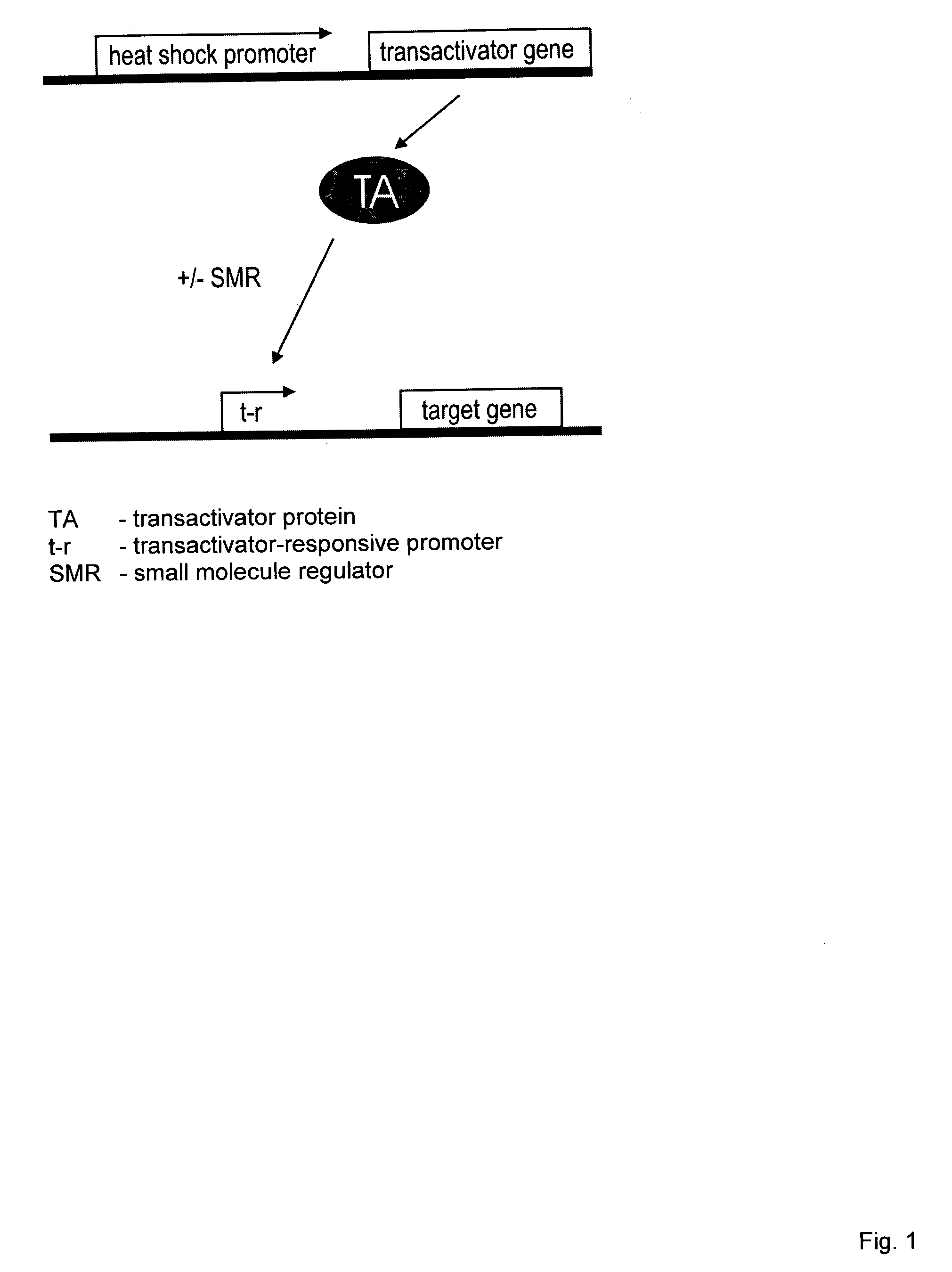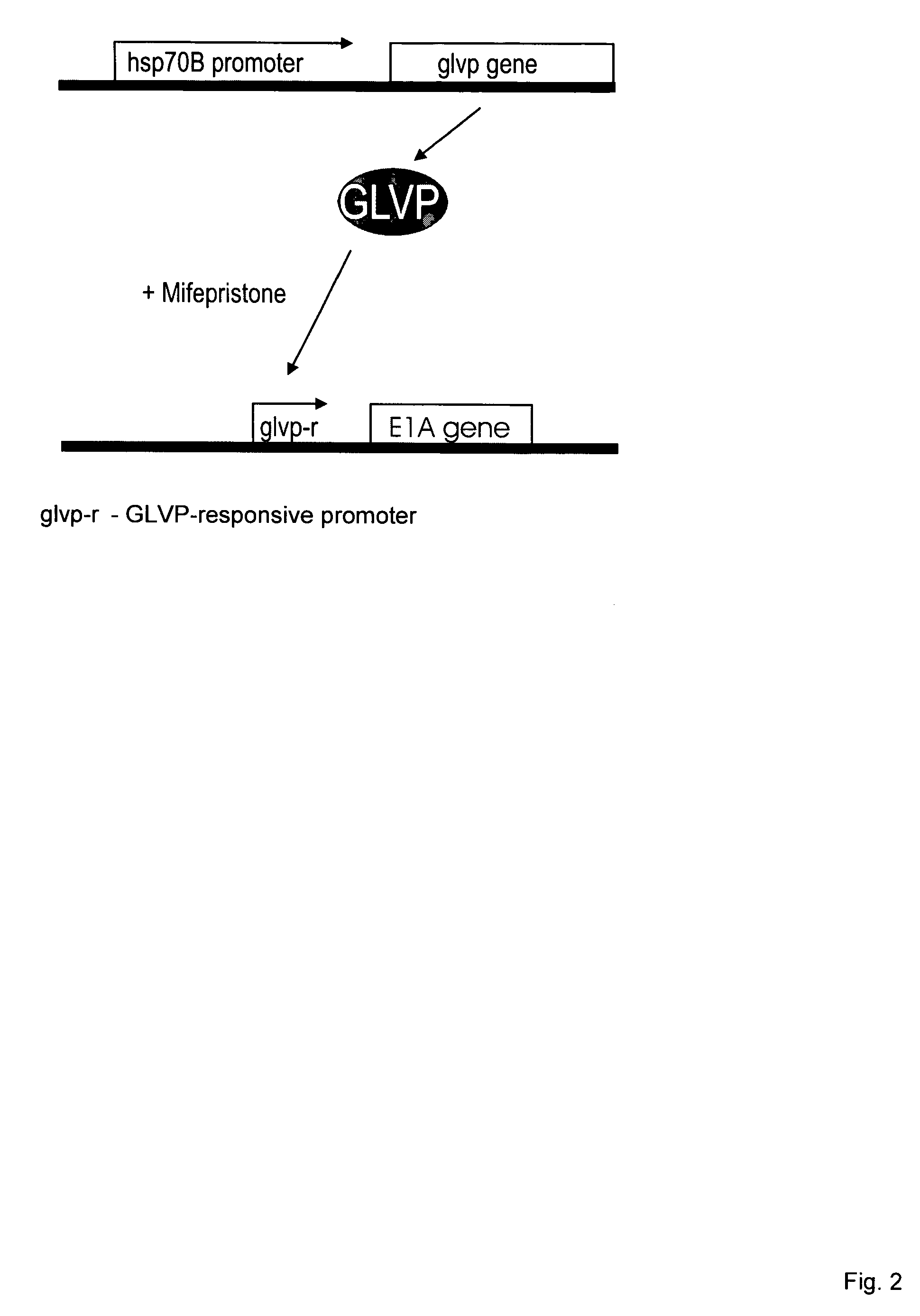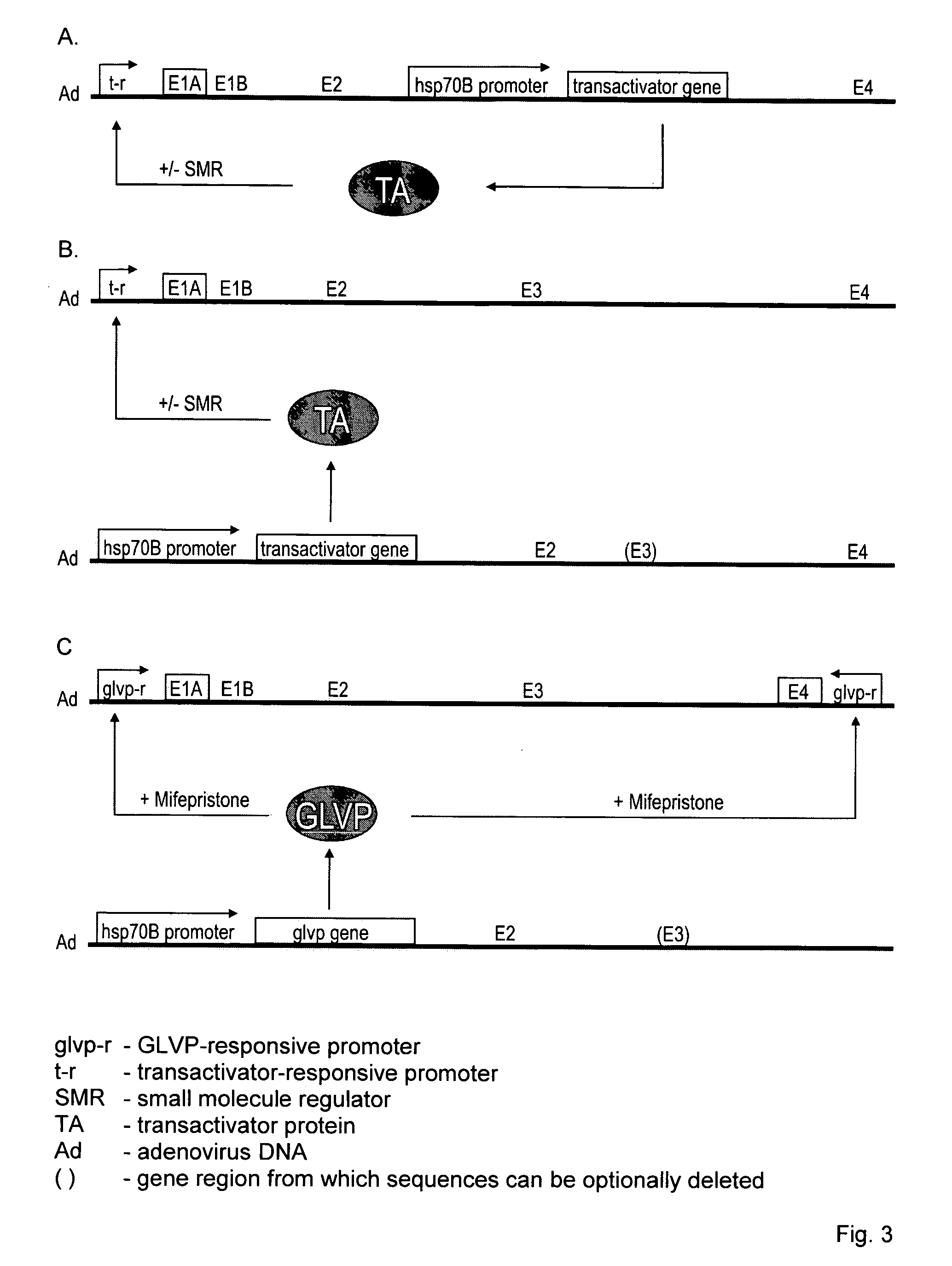[0003] The present invention relates to a modified, conditionally replication-competent virus whose genome includes a gene switch activatable in an infected cell by exposure of the cell to heat and a small molecule regulator, the gene switch controlling the expression of a gene for a viral protein required for efficient replication of the modified virus. The invention similarly relates to a modified, conditionally replication-competent virus whose genome includes a gene switch that is activated in an infected cell by exposure of the cell to heat and is repressed by exposure of the cell to a small molecule regulator, the gene switch controlling the expression of a gene for a viral protein required for efficient replication of the modified virus. A modified, conditionally replication-competent virus of the invention may further include a passenger gene. Expression of the passenger gene can also be regulated by the gene switch that controls viral replication. Preferably, a modified, conditionally replication-competent virus is derived from a member of the Adenoviridae, Herpesviridae, and Retroviridae families. Most preferably, a modified, conditionally replication-competent virus is derived from a member of the Adenoviridae family. If the modified, conditionally replication-competent virus is an adenovirus, the genes that can be controlled by the gene switch include the E1A, E1B and E4 genes. The gene switch that controls the expression of one or more viral genes, whose product is required for or facilitates viral replication, comprises two components. The first component is a gene for a transactivator that is activated or inhibited by a small molecule regulator. In preferred embodiments, expression of the transactivator gene is controlled by a heat shock promoter activatable by transient heat or a transient proteotoxic stress through the intermediary of endogenous heat shock factor 1 (HSF1), or by a tandem or hybrid promoter activatable by transient heat or proteotoxic stress through the intermediary of endogenous HSF1 and by active transactivator, The second component of the switch is a promoter activated by the active form of the transactivator, which promoter is functionally linked to a viral or passenger gene to be regulated. In alternative embodiments, the first component is a transactivator gene that is expressed continuously (constitutively) in a host cell. The second component can be a modified heat shock promoter (including an appropriate RNA leader region) that is activated by transient heat or other proteotoxic stress and repressed by the transactivator. Binding of a small molecule regulator to the transactivator can, respectively, inhibit or enable its repressing function. Hence, the resulting gene switch is active in cells exposed to heat or proteotoxic stress in the presence or absence, respectively, of the small molecule regulator. The second component can also be a modified (or partial) heat shock promoter that requires co-activation by transactivator and endogenous HSF1. In this case, transactivator is activated by a bound small molecule regulator.
[0004] The invention also relates to a pair of modified viruses whose combined genomes contain all genetic information required for conditional replication of the virus pair; including a gene switch activatable in an infected cell by exposure of the cell to heat and a small molecule regulator, the gene switch controlling the expression of a gene for a viral protein required for efficient replication of the virus pair. The invention further concerns a pair of modified viruses whose combined genomes contain all genetic information required for conditional replication of the virus pair; including a gene switch that is activated in an infected cell by exposure of the cell to heat and is repressed by exposure of the cell to a small molecule regulator, the gene switch controlling the expression of a gene for a viral protein required for efficient replication of the virus pair. A pair of modified viruses of the invention may further include a passenger gene that is inserted into the genome of one or the other virus of the pair. The passenger gene can also be controlled by the gene switch that controls viral replication. Preferably, the modified viruses of a pair are modified members of the Adenoviridae, Herpesviridae, and Retroviridae families. Most preferably, each virus of a pair is derived from a member of the Adenoviridae family. If both viruses of a pair of the invention are modified adenoviruses, the genes that can be controlled by the gene switch include the E1A, E1B and E4 genes. The gene switch that controls the expression of one or more viral genes, whose product is required for or facilitates viral replication, comprises two components. The first component is a gene for a transactivator that is activated or inhibited by a small molecule regulator. In preferred embodiments, expression of the transactivator gene is controlled by a heat shock promoter activatable by transient heat or a transient proteotoxic stress through the intermediary of endogenous heat shock factor 1 (HSF1), or by a tandem or hybrid promoter activatable by transient heat or proteotoxic stress through the intermediary of endogenous HSF1 and by active transactivator, The second component of the switch is a promoter activated by the active form of the transactivator, which promoter is functionally linked to a viral or passenger gene to be regulated. In alternative embodiments, the first component is a transactivator gene that is expressed continuously (constitutively) in a host cell. The second component can be a modified heat shock promoter (including an appropriate RNA leader region) that is activated by transient heat or other proteotoxic stress and repressed by the transactivator. Binding of a small molecule regulator to the transactivator can, respectively, inhibit or enable its repressing function. Hence, the resulting gene switch is active in cells exposed to heat or proteotoxic stress in the presence or absence, respectively, of the small molecule regulator. The second component can also be a modified (or partial) heat shock promoter that requires co-activation by transactivator and endogenous HSF1. In this case, transactivator is activated by a bound small molecule regulator.
 Login to View More
Login to View More 


